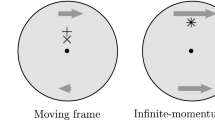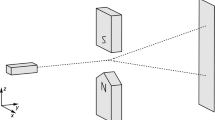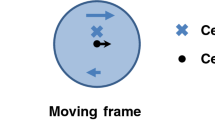Abstract
Recently, for spinless non-relativistic particles, Norsen (Found Phys 40:1858–1884, 2010) and Norsen et al. (Synthese 192:3125–3151, 2015) show that in the de Broglie–Bohm interpretation it is possible to replace the wave function in the configuration space by single-particle wave functions in physical space. In this paper, we show that this replacment of the wave function in the configuration space by single-particle functions in the 3D-space is also possible for particles with spin, in particular for the particles of the EPR-B experiment, the Bohm version of the Einstein–Podolsky–Rosen experiment.



Similar content being viewed by others
References
Norsen, T.: The theory of (exclusively) local beables. Found. Phys. 40, 1858–1884 (2010)
Noren, T., Marian, D., Oriols, X.: Can the wave function in configuration space be replaced by single-particle wave function in physical space? Synthese 192, 3125–3151 (2015)
de Broglie, L.: La Nouvelle Dynamique des quanta. In: Electrons et Photons, Rapports du Cinquième Conseil de Physique Solvay, pp. 118–119. Gauthier-Villard, Paris (1928). Translated in [5], The New Dynamics of Quanta, 385
Schrödinger, E.: La mécanique des ondes. In: Electrons et Photons, Rapports du Cinquième Conseil de Physique Solvay, pp. 118–119. Gauthier-Villard, Paris (1928). Translated in [5], The Mechanics of Waves, 447
Bacciagaluppi, G., Valentini, A.: Quantum Theory at the Crossroads. Cambridge University Press, Cambridge (2009). arXiv:quant-ph/0609184
Dürr, D., Goldstein, S., Zanghi, N.: Quantum equilibrium and the origin of absolute uncertainty. J. Stat. Phys. 67, 843–907 (1992)
Dürr, D., Goldstein, S., Zanghi, N.: Quantum equilibrium and the role of operators as observables in quantum theory. J. Stat. Phys. 116, 959–1055 (2004)
Takabayasi, T.: The vector representation of spinning particle in quantum theory. Prog. Theor. Phys. 14, 283–302 (1955)
Bohm, D., Schiller, R., Tiommo, J.: A causal interpretation of the Pauli equation. Supplemento al Nuovo Cimento 1, 48–66 (1955)
Dewdney, C., Holland, P.R., Kyprianidis, A.: A causal account of non-local Einstein–Podolsky–Rosen spin correlations. J. Phys. A Math. Gen. 20, 4717–4732 (1987)
Dewdney, C., Holland, P.R., Kyprianidis, A.: What happens in a spin measurement? Phys. Lett. 11A9, 259–267 (1986)
Kochen, S., Specker, E.: The problem of hidden variables in quantum mechanics. J. Math. Mech. 17, 59–87 (1967)
Bohm, D., Hiley, B.J.: The Undivided Universe. Routledge, London (1993)
Feynman, R.P., Leighton, R.B., Sands, M.: The Feynman Lectures on Physics. Addison-Wesley, New York (1965)
Cohen-Tannoudji, C., Diu, B., Laloë, F.: Quantum Mechanics. Wiley, New York (1977)
Sakurai, J.J.: Modern Quantum Mechanics. Addison-Wesley, Reading (1985)
Le Ballac, M.: Quantum Physics. Cambridge University Press, Cambridge (2006)
Gondran, M., Gondran, A.: A complete analysis of the Stern–Gerlach experiment using Pauli spinors. (2005). arXiv:quant-ph/0511276
Gondran, M., Gondran, A., Kenoufi, A.: Decoherence time and spin measurement in the Stern–Gerlach experiment. AIP Conf. Proc. 1424, 116–120 (2012)
Gondran, M., Gondran, A.: A new causal interpretation of the EPR-B experiment. AIP Conf. Proc. 1508, 370 (2012)
Dewdney, C., Holland, P.R., Kyprianidis, A., Vigier, J.P.: Spin and non-locality in quantum mechanics. Nature 336, 536–544 (1988)
Holland, P.R.: The Quantum Theory of Motion. Cambridge University Press, Cambridge (1993)
Albert, D.: Quantum Mechanics and Experience. Harvard University Press, Cambridge (1992)
Acknowledgments
Authors gratefully acknowledge the two anonymous reviewers for their useful comments and constructive suggestions which helped to improve the paper.
Author information
Authors and Affiliations
Corresponding author
Appendix: Spin “Measurement ” in the Stern–Gerlach Experiment
Appendix: Spin “Measurement ” in the Stern–Gerlach Experiment
The measurement of spin of a silver atom is carried out by a Stern–Gerlach apparatus: an electromagnet A, where there is a strongly inhomogeneous magnetic field, followed by a screen P (Fig. 4). In the Stern–Gerlach experiment, silver atoms contained in the oven E are heated to a high temperature and escape through a narrow opening. A second aperture, T, selects those atoms whose velocity, \(v_0\), is parallel to the y-axis. The atomic beam passes through the gap of the electromagnet A, before condensing on the screen P on two spots of equal intensity \(N^{+}\) and \(N^{-}\). The magnetic moment of each silver atom before crossing the electromagnet is oriented randomly (isotropically).
In the beam, we represent the atoms by their wave function; one can assume that at the entrance to the electromagnet A (at the initial time \(t=0\)), each atom can be approximatively described by a Gaussian spinor in x and z:
corresponding to a pure state. The variable y is treated in a classical way with \(y=v_0 t\).
In (30), \(\theta _0 \) and \(\varphi _0 \) characterize the initial orientation of the spin. This initial orientation being randomized, on may suppose that \(\theta _0 \) is drawn in a uniform law from [0, \(\pi \)] and that \(\varphi _0 \) is drawn in a uniform law from [0, 2\(\pi \)]; In this way, we obtain a beam of atoms in which each atom has a different spinor: this is a model of a mixture of pure states.
In the Copenhagen interpretation, it is not necessary to resolve the Pauli equation. Just applying the postulates of quantum-mechanics measurement is sufficient. For measurement of the spin along the z-axis, the postulate of quantification states that the measurement corresponds to an eigenvalue of the spin operator \(S_z =\frac{\hbar }{2}\sigma _z\), and the spectral decomposition postulate states that Eq. (7) gives probability \(cos^2 \frac{\theta }{2}\) (resp. \(sin^2 \frac{\theta }{2}\)) to measure the particle in the spin state \(+ \frac{\hbar }{2}\) (resp.\( -\frac{\hbar }{2}\)).
In the de Broglie–Bohm interpretation, the postulates of quantum mechanics measurement are not used, but demonstrated (see below). The results of the measurement are obtained, first by calculating the evolution of the wave function in interaction with the measuring apparatus with the Pauli equation (Eq. 1), secondly by using the calculation of the wave function in space and time to pilot the particle (Eq. 2).
Let us consider the evolution of the initial wave function (5) in the Stern–Gerlach apparatus. To obtain an explicit solution to the Stern–Gerlach experiment, we take the numerical values used in the Cohen–Tannoudji textbook [15]. For a silver atom, we have \(m = 1.8 \times 10^{-25}\) kg, \(v_0 = 500\) m/s , \(\sigma _0\)=10\(^{-4}\) m. For the electromagnetic field \(\mathbf {B}\), \(B_{x}=B'_{0} x\); \(B_{y}=0\) and \(B_{z}=B_{0} -B'_{0} z\) with \(B_{0}=5\) T, \(B'_{0}=\left| \frac{\partial B}{\partial z}\right| =- \left| \frac{\partial B}{\partial x}\right| = 10^3\) T/m over a length \(\Delta l=1\) cm.
The variable y will be treated classically with \(y=v_0t\). The particle stays within the magnetic field for a time \(\Delta t= \frac{\Delta l}{v_0}=2 \times 10^{-5}s \). On exiting the magnetic field, the particle is free until it reaches screen P placed at a \(D=20\) cm distance.
During this time \([0,\Delta t]\), the spinor is calculated (Dürr et al. [7], Gondran [18]) with the Pauli equation (1), where \(\mu =\frac{e\hbar }{2m_e}\) is the Bohr magneton:
After the magnetic field, at time \(t+ \Delta t\) \((t \ge 0)\), in the free space, the spinor becomes [18]
where
Equation (32) takes into account the spatial extension of the spinor and we note that the two-spinor components have very different values.
Since we have a mixture of pure states, the atomic density \(\rho (z,t+\Delta t)\) is found by integrating \(\rho (x, z,t+\Delta t) \) on x and on (\(\theta _0\), \( \varphi _0\)):
The decoherence time \(t_D\), where the beam is separated into the two spots \(N^{+}\) and \(N^{-}\) (when \(z_{\Delta } +u t_D \geqslant 3\sigma _0\)), is then given by the equation:
We then obtain atoms with spins oriented only along the z-axis (positively or negatively). Experimentally, we do not measure the spin directly, but position (\(\widetilde{x}\), \(\widetilde{z}\)) of the particle impact on P. If \(\widetilde{z}\in N^+\), the term \(\psi ^-\) of (32) is numerically equal to zero, and the spinor \(\Psi \) is proportional to \(\left( {\begin{array}{c}1\\ 0\end{array}}\right) \), one of the eigenvectors of \(\sigma _z\):
If \(\widetilde{z}\in N^-\), the term \(\psi ^+\) of (32) is numerically equal to zero and the spinor \(\Psi \) is proportional to \(\left( {\begin{array}{c}0\\ 1\end{array}}\right) \), the other eigenvector of \( \sigma _z \):
Therefore, the measurement of the spin corresponds to an eigenvalue of the spin operator \(S_z= \frac{\hbar }{2} \sigma _z \). It is a proof of the postulate of quantization in Bohmian mechanics.
Equation (32) gives the probability \( \cos ^{2} \frac{\theta _0}{2} \) (resp.\( \sin ^{2} \frac{\theta _0}{2} \)) of measuring the particle in the spin state \(+ \frac{\hbar }{2}\) (resp.\(- \frac{\hbar }{2}\)). It is a proof of the spatial decomposition postulate in Bohmian mechanics.
Figure 5 presents in x0y a set of 10 silver-atom trajectories of which initial characteristics \((\theta _0\),\(\varphi _0\),\(z_0\)) have been randomly chosen: \(\theta _0\) and \(\varphi _0\), which define on one hand the wave function, have uniform distributions, and \(z_0^A\), which on the other hand defines the particle position in the wave function, has a normal distribution \(\mathcal {N}(0,\sigma _{0})\). This double representation of quantum particles allows to take into account a mixture of pure states which satisfies the density of (34). Spin orientation \(\theta (z(t),t)\) is represented by arrows.
We can see that the final orientation, obtained after the decoherence time \(t_{D}\), will depend on the initial particle position \(z_{0}^A\) in the wave packet and on the initial angle \(\theta _{0}^A\) of the atom magnetic moment with the z axis.
Finally, we can also give a clear explanation of the Albert’s example on contextuality [23, pp. 153–155]. He considers a Stern–Gerlach experiment where the initial wave function is a pure state with symmetric spin orientation (\(\theta _0 =\dfrac{\pi }{4}\) and so \(z^{\theta _0}=0\)). He changes, in a second experiment, the orientation of the magnetic field inside the Stern–Gerlach apparatus (\(\mathbf {B}\) into \(-\mathbf {B}\)). For the same initial position of atoms ( for example \(z_0 > 0\)), the first experiment gives a spin + and, in the second, a spin \(-\). Bohmian mechanics explains this result: u and \(z_{\Delta }\) are proportional to \(B'_0 =\dfrac{\partial B_{z}}{\partial z} \) (Eq. 33), and therefore change their signs like \(\mathbf {B}\). By solving the Pauli equation, Bohmian mechanics is naturally contextual (involves the measuring device).
Rights and permissions
About this article
Cite this article
Gondran, M., Gondran, A. Replacing the Singlet Spinor of the EPR-B Experiment in the Configuration Space with Two Single-Particle Spinors in Physical Space. Found Phys 46, 1109–1126 (2016). https://doi.org/10.1007/s10701-016-0011-1
Received:
Accepted:
Published:
Issue Date:
DOI: https://doi.org/10.1007/s10701-016-0011-1






